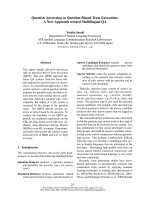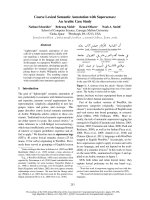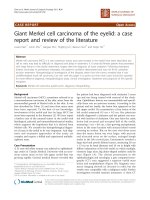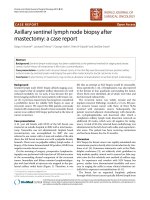báo cáo khoa học: "Pheochromocytoma presenting as recurrent urinary tract infections : a case report" docx
Bạn đang xem bản rút gọn của tài liệu. Xem và tải ngay bản đầy đủ của tài liệu tại đây (843.33 KB, 8 trang )
CAS E REP O R T Open Access
Pheochromocytoma presenting as recurrent
urinary tract infections : a case report
Roisin T Dolan
1,2*
, Joseph S Butler
1
, Gerard P McEntee
1
, Maria M Byrne
2
Abstract
Introduction: Pheochromocytomas are rare, potentially fatal, neuroendocrine tumors of the adrenal medulla or
extra-adrenal paraganglia. Their clinical presentation varies greatly from the classic triad of episodic headach e,
diaphoresis and tachycardia to include a spectrum of non-specific symptomatology.
Case presentation: A 43-year-old Caucasian woman was referred to us from primary care services with a three-
month history of recurrent urinary tract infections on a background of hypertension, latent autoimmune diabetes
of adulthood and autoimmune hypothyroidism. At 38 years she required insulin therapy. Despite medication
compliance and dietary control, she reported a recent history of increased insulin requirements and uncontrolled
hypertension with concomitant recurrent urinary tract infections. A renal ultrasound examination, to rule out
underlying renal pathology, revealed an incidental 8cm right adrenal mass of both solid and cystic components.
A subsequent computed tomography of her abdomen and pelvis confirmed a solid heterogeneous mass
consistent with a pheochromocytoma. There were no other features suggestive of multiple endocrine neoplasia.
Urinary collection over 24 ho urs revealed grossly elevated levels of catecholamines and metabolites. Following an
open right adrenalectomy, our patient’s insulin requirements were significantly reduced and her symptoms
resolved. Two weeks post-operatively, an iodine-131-metaiodobenzylguanidine scintigraphy was negative for
residual tumor and metastatic disease. Urinary catecholamine and metabolite concentrations were within the
normal range at a follow-u p six months later.
Conclusion: Pheochromocytoma is a rare catecholamine-producing tumor requiring a high index of suspicion for
early diagnosis. Our case report serves to highlight the importance of considering pheochromocytoma as a
differential diagnosis in the atypical setting of recurrent urinary tract infections and concomitant autoimmune
disease.
Introduction
Pheochromocytoma is a rare, insidious adrenal medul-
lary neuroendocrine tumor representing approximately
5% of adrenal incidentalomas [1]. It is a sympathetic
paraganglioma of chromaffin cell origin and catechola-
mine hyper secretion is a common clinical manifestation
[2,3]. Today, 25% of all pheochromocytomas are discov-
ered incidentally during imaging studies for unrelated
disorders.
Clinical awareness of the variable manifestations of
this insidious tumor is key for early diagnosis and opt i-
mal patient management. Clinical presentation varies
from the classic triad of episodic headache, diaphoresis
and tachycardia to include a spectrum of non-specific
symptomatology. Despite improved diagnostic techni-
ques, there remains an approximate delay of three years
between initial symptoms and a final diagnosis.
We discuss an atypical case of a 43-year-old woman pre-
senting with recurrent urinary tract infections in the setting
of an undiagnosed pheochromocytoma. We review the
contribution of catecholamine hypersecretion to patient
symptomatology and the unique association of pheochro-
mocytoma with other autoimmune endocrinopathies.
Case Presentation
A 43-year-old Caucasian woman presented to our pri-
mary care services with a three-month h istory of recur-
rent, laboratory confirmed Escherichia coli urinary tract
* Correspondence:
1
Department of Surgery, Mater Misericordiae University Hospital, Eccles
Street Dublin 7, Ireland
Full list of author information is available at the end of the article
Dolan et al. Journal of Medical Case Reports 2011, 5:6
/>JOURNAL OF MEDICAL
CASE REPORTS
© 2011 Dolan et al; licensee BioMed Central Ltd. This is an Open Access article distributed under the terms of the Creative Commons
Attribution License ( which permits unrestricted use, distribution, and reproduction in
any medium, provided the original work is properly ci ted.
infections. She was diagnosed with gestational diabetes
at age 33 years, and in the postpartum period, diet con-
trolled type 2 diabetes mellitus and concomitant hyper-
tension were confirmed. She required insulin therapy
some five years later, and, following seropositivity to
anti-glutamic acid decarboxylase antibodies, was diag-
nosed with latent autoimmune diabetes of adulthood
(LADA). In a ddition, she developed auto immune
hypothyroidism at age 38 years. Despite medication
compliance and dietary control, she reported a recent
history of increased insulin requirements and uncon-
trolled hypertension with concomit ant recurrent urinary
tract infections. Our patient is not sexually active.
Renal ultrasound examination, to rule out underlying
renal pathology, revealed an incidental 8cm right adre-
nal mass of both solid and cystic components (Figure 1).
A subsequent non-contrast computed tomography (CT)
of the abdomen and pelvis confirmed a solid heteroge-
neous mass consistent with a pheochromocytoma, 9cm
in maximal dimension. No regional adenopathy, vascular
invasion or metastatic disease was evident (Figure 2).
There were no other features suggestive of multiple
endocrine neoplasia. On physical examination, her blood
pressure was elevated at 160/90mmHg with no ortho-
static changes. Her fasting blood glucose was 12mmol/L
and her glycated hemoglobin level (HbA1C) was 9.9%.
Her body mass index was within the normal range at
22.5. A 24-hour urinary collection provided biochemical
confirmation with grossly elevated levels of catechola-
mines and metabolites (Figure 3).
Followinga10-daycourseofphenoxybenzamine
a-adrenergic blockade, the patient underwent an open
right adrenalectomy. The immediate post-operative per-
iod was complicated by profound episodes of hypoten-
sion, requiring three days of inotropic support in high
dependency care. Her recovery after this period was
uncomplicated with an observed reduction in insulin
requirements and anti-hypertensive therapy (Figure 4).
Histopathological examination of the excised tissue
confirmed a 9.5x9.6cm solid heterogeneous tumor arising
from her right adrenal medulla (Figure 5). Microscopic
evaluation revealed Zellballen cellular architecture, a
Figure 1 Abdominal ultrasound depicting a large mixed cystic/solid right adrenal mass.
Dolan et al. Journal of Medical Case Reports 2011, 5:6
/>Page 2 of 8
distinct characteristic of paragangliomas. There was no
invasion of adjacent tissues or blood vessels and the
MIB-1 proliferation index was 3%, fa vorin g benign beha-
vior (Figure 6). Iodine-131-metaiodobenzylguanidine
(MIBG) scintigraphy performed two weeks post-opera-
tively confirmed complete excision with no evidence of
metastatic disease (Figure 7). Two years post-operatively
our patient is symptom-free with normal urinary cate-
cholamines and metabolites. She denies any further
recurrence of urinary tract infections post-operatively.
She continues to t ake anti-hypertensive and insulin
therapy.
Discussion
Pheochromocytomas are rare, adrenal medullary neuroen-
docrine tumors with a worldwide incidence of two to
eight per million which peaks in the fourth and fifth dec-
ades of life [4,5]. Forty percent of pheochromocytomas are
asymptomatic and discovered incidentally during radiolo-
gic imaging [4,5]. Forty p ercent of pheo chromocytomas
present with the classic triad of paroxysmal headache, dia-
phoresis and tachycardia. Hypertensive crisis may develop
in some patients resulting in cardiovascular shock with
stroke, myocardial infarction, or multiple organ failure
[5,6]. Pheochromocytoma detection poses an immense
clinical challenge as these insidious neoplasms can mas-
querade as a spectrum of non-specific symptomatologies;
numerous atypic al presentations of this unique neoplasm
have been reported in the literature [6-11].
The lethal nature of this neoplasm is dependent on two
major characteristics. The first of these is its ability to
secrete excess catecholamines, resulting in potentially cat-
astrophic consequences. The second is its malignant
potential. In this context, a multidisciplinary team
approach involving anesthesia, surgical and endocrinologi-
cal expertise is necessary to maximize optimal patient out-
come [3,12]. Surgical resec tion is the definitive treatment
for patients with pheochromocytoma [3,12]. With increas-
ing worldwide expertise, laparoscopic adrenalectomy is
now regarded as the gold standard for approximately 60%
Figure 2 CT abdomen further illustrating a solid heterogeneous right adrenal mass with focal cystic degeneration, slightly displacing
the right kidney.
Dolan et al. Journal of Medical Case Reports 2011, 5:6
/>Page 3 of 8
of patients requiri ng adrenalectomy including pheochro-
mocytoma [13]. It is recommended that only experienced
surgeons perform the procedure and that the approach
take into ac count the type, size, site and hereditary back-
ground of the tumor [12]. However, open trans-peritoneal
surgery is indicated when tumors are multiple, large
tumors of a size greater than 8 to 10cm, or when the
tumor will be difficult to remove using laparoscopy
[12,13]. In our case, an open approach was undertaken to
reduce intra-operative mechanical mobilization of the
large tumor, which can potentially st imulate surges of
catecholamine secretion, prec ipitating hypertensive crises
and fatal arrhythmias. It is recommended that all patients
receive 7 to 10 days of a-adenoreceptor antagonists
pre-operatively to prevent catecholamine -induced vasocon-
striction. There is no specific recommendation on the pre-
ferred drugs for pre-operative blockade; a-adenoreceptor
antagonists, calcium-ch annel blockers and angiotension-
receptor blockers have all been proven beneficial [12].
The association of pheochromocytoma with other
endocrinopathies is a rare yet recognized phenomenon.
Previous studies have conclud ed that diabetes mellitus is
present in up to a third of patient s presenting with pheo-
chromocyotma [7,8,14]. This umbrella term encompasses
type 1, type 2 and gestational diabetes mellitus. Catecho-
lamine overproduction leads to both decreased insulin
secretion and increased peripheral resistance to insulin
action, by stimulating a2andb2 adenorecept ors respec-
tively. Following adrenalectomy, some patients revert to
normogl ycamia with a normal glucose tolerance test, yet
a proportion of patients continue to display features of
glucose intolerance, although to a lesser extent, as
demonstrated in our case [ 7,8]. It has been reported that
a proportion of this latter group display seropositivity to
pancreatic islet cell auto-antibodies [8]. Recent literature
has also reported a rare association of autoimmune hypo-
and hyperthyroidism with pheochr omocytoma [9]. Thus,
a high index of suspicion for pheochromocytoma should
Figure 3 Catecholamine and metabolite concentrations before and after adrenalectomy, tak en from 24-hour urine sample.Normal
ranges: noradrenaline (0-900nmol/24h); adrenaline (0-230nmol/24h); dopamine (0-3300 nmol/24h); normetanephrine (50-2800nmol/24h);
metanephrine (25-1800nmol/24h).
Dolan et al. Journal of Medical Case Reports 2011, 5:6
/>Page 4 of 8
be maintained in the context of concomitant endocrino-
pathies and typical or atypical symptomatology.
To the best of our knowledge, there have been no pre-
vious cases reported in the current literature in which
a patient presents with recurrent urinary tract infections
in association with pheochromocytoma. We postulate
that catecholamine overproduction in pheochromocy-
toma causes decreased insulin secretion and increased
end-organ resistance, resulting in hyperglycaemia. Stu-
dies have demonstrated impairment of host defenses,
including decreased polymorphonuclear leukocyte mobi-
lization, chemotaxis, and phagocytic activity related to
hyperglycemia [15]. Recent literature has reported per-
sistent neutrophilia as a preceding symptom of pheo-
chromocytoma. However, catecholamine overproduction
is known to provoke neutrophilia and mimic sepsis,
thus a laboratory confirmed urinary tract infection with
an identified causative agent is necessary in the context
of this unusual tumor.
Conclusion
Pheochromocytoma is a rare catecholamine-producing
tumor with potential life-threatening consequences.
Clinical manifestations unique to this tumor are occa-
sional atypical and non-specific symptomatology and its
association with autoimmune disorders. A multidisci-
plinary approach involving anesthesia, endocrinology
and surgical expertise is the gold standard in maximiz-
ing patient care. This case exhibits a rare combination
of pheochromocytoma with LADA and autoimmune
hypothyroidis m. Here we highlight the importance of
considering pheochromocytoma as a differential diagno-
sis in the setting of recurrent urinary tract infections
and concomitant autoimmune endocrinopathies.
Figure 4 Graph displaying the dramatic reduction in insulin r equirements and HbA1C following adrenalectomy for
pheochromocytoma.
Dolan et al. Journal of Medical Case Reports 2011, 5:6
/>Page 5 of 8
Figure 5 Gross adrenal pheochromocytoma specimen following surgical excision.
Figure 6 (a) Low power (10X) image depicting nests of tumour cells with prominent intervening capillary network giving
characteristic Zellballen appearance; (b) High power (20X) image highlighting the presence of abundant finely granular amphophilic
cytoplasm, round nuclei, marked focal nuclear pleomorphism and tumor giant cells. These findings do not correlate with malignant
behavior.
Dolan et al. Journal of Medical Case Reports 2011, 5:6
/>Page 6 of 8
Consent
Written informed consent was obtained from the patient
for publication of this case report and any accompany-
ing images. A copy of the written consent is available
for review by the Editor-in-Chief of this journal.
Author details
1
Department of Surgery, Mater Misericordiae University Hospital, Eccles
Street Dublin 7, Ireland.
2
Department of Endocrinology, Mater Misericordiae
University Hospital, Eccles Street, Dublin 7, Ireland.
Authors’ contributions
RD conceived the study, acquired patient data and drafted the manuscript.
JB critically reviewed the manuscript. All authors contributed intellectual
content and have read and approved the final manuscript.
Competing interests
The authors declare that they have no competing interests.
Received: 5 February 2010 Accepted: 12 January 2011
Published: 12 January 2011
References
1. Mantero F, Terzolo M, Arnaldi G, Osella G, Masini AM, Alì A, Giovagnetti M,
Opocher G, Angeli A: A survey on adrenal incidentaloma in Italy. Study
Group on Adrenal Tumors of the Italian Society of Endocrinology. J Clin
Endocrinol Met 2000, 85(2):637-644.
2. Tischler AS, Kimura N, McNicol AM: Pathology of pheochromocytoma and
extra-adrenal paraganglioma. Ann N Y Acad Sci 2006, 1073 :557-570.
3. Lenders JW, Eisenhofer G, Mannelli M, Pacak K: Phaeochromocytoma.
Lancet 2005, 366(9486):665-675.
4. Amar L, Bertherat J, Baudin E, Ajzenberg C, Bressace-de Paillerets B,
Chabre O, Chamontin B, Delemer B, Giraud S, Murat A, Niccoli-Sire P,
Richard S, Rohmer V, Sadoul JL, Strompf L, Schlumberger M, Bertagna X,
Plouin PF, Jeunumaitre X, Gimenz-Roqueplo AP: Genetic testing in
pheochromocytoma or functional paraganglioma. J Clin Oncol 2005,
23(34):8812-8818.
5. Reisch N, Peczkowska M, Januszewicz A, Neumann HP:
Pheochromocytoma: presentation, diagnosis and treatment. J Hypertens
2006, 24(12):2331-2339.
6. Huddle KR: Phaeochromocytoma by way of case reports. Cardiovasc J S
Afr 2002, 13(4):205-208.
7. Nair S, Hossain S, Winocour P: Pheochromocytoma presenting as Type 1
Diabetes Mellitus. Endocrine abstracts 2006, 12:59.
8. Murao K, Imachi H, Sato M, Dobashi H, Tahara R, Haba R, Kakehi Y, Ishida T:
A case of pheochromocytoma complicated with slowly progressive type
1 diabetes mellitus and chronic thyroiditis. Endocrine 2007, 32(3):350-353.
9. Bartolomei C, Gianchecchi D, Chiavistelli P, Lenzi R: [Pheochromocytoma
and autoimmune hypothyroidism.]. Minerva Med 1992, 83(7-8):485-486.
10. Myers MG, Arshinoff SA: Infection and pheochromocytoma. JAMA 1977,
237(19):2095-2096.
11. Fred HL, Allred DP, Garber HE, Retiene K, Lipscomb H: Pheochromocytoma
masquerading as overwhelming infection. Am Heart J 1967, 73(2):149-154.
12. Pacak K, Eisenhofer G, Ahlman H, Bornstein SR, Gimenez-Roqueplo AP,
Grossman AP, Kimura N, Mannelli M, McNicol AM, Tischler AS, International
Symposium on Pheochromocytoma: Pheochromocytoma:
recommendations for clinical practice from the First International
Symposium. October 2005. Nat Clin Pract Endocrinol Metab 2007,
3(2):92-102.
13. Salamah AM: Surgery for pheochromocytoma: a prospective clinico-
epidemiological study. Ann Saudi Med 2002, 22(5-6):392-395.
Figure 7 MIBG scintigraphy two weeks post-adrenalectomy displaying no evidence of residual chromaffin cell uptake or metastatic
disease.
Dolan et al. Journal of Medical Case Reports 2011, 5:6
/>Page 7 of 8
14. La Batide-Alanore A, Chatellier G, Plouin PF: Diabetes as a marker of
pheochromocytoma in hypertensive patients. J Hypertens 2003,
21(9):1703-1707.
15. Butler SO, Btaiche IF, Alaniz C: Relationship between hyperglycemia and
infection in critically ill patients. Pharmacotherapy 2005, 25(7):963-976.
doi:10.1186/1752-1947-5-6
Cite this article as: Dolan et al.: Pheochromocytoma presenting as
recurrent urinary tract infections : a case report. Journal of Medical Case
Reports 2011 5:6.
Submit your next manuscript to BioMed Central
and take full advantage of:
• Convenient online submission
• Thorough peer review
• No space constraints or color figure charges
• Immediate publication on acceptance
• Inclusion in PubMed, CAS, Scopus and Google Scholar
• Research which is freely available for redistribution
Submit your manuscript at
www.biomedcentral.com/submit
Dolan et al. Journal of Medical Case Reports 2011, 5:6
/>Page 8 of 8









